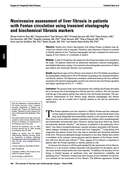Noninvasive assessment of liver fibrosis in patients with Fontan circulation using transient elastography and biochemical fibrosis markers.
The Journal of thoracic and cardiovascular surgery
Friedrich-Rust M, Koch C, Rentzsch A, Sarrazin C, Schwarz P, Herrmann E, Lindinger A, Sarrazin U, Poynard T, Schäfers HJ, Zeuzem S, Abdul-Khaliq H
2008 J. Thorac. Cardiovasc. Surg. Volume 135 Issue 3
PubMed 18329470 DOI 10.1016/j.jtcvs.2007.09.039
OBJECTIVE
Studies have shown that patients with failing Fontan circulation may develop liver cirrhosis with its sequelae. Therefore, early detection of fibrosis is essential to identify patients at risk. Transient elastography has been evaluated for noninvasive staging of liver fibrosis in a multitude of studies.
METHODS
A total of 39 patients who underwent the Fontan procedure were included in the study. All patients underwent an abdominal ultrasound, transient elastography, and detailed laboratory testing. Conventional echocardiography assessment of inflow and outflow and ventricular function were performed.
RESULTS
Significant signs of liver fibrosis were found in 36 of 39 children according to the elastography method and in 28 of 39 children according to the measured biochemical fibrosis markers. The Spearman correlation coefficient between the liver stiffness measured with transient elastography and the time interval since the Fontan operation was highly significant (0.514, P = 0.001).
CONCLUSION
The present study shows that patients who undergo the Fontan procedure are at increased risk of developing liver fibrosis and liver cirrhosis. The risk increases with the age of the patient and the time interval since the Fontan procedure. The noninvasive measurement of liver fibrosis using transient elastography and fibrosis marker scores can be a useful tool to identify patients at risk and for noninvasive surveillance.
Citation Reference:

